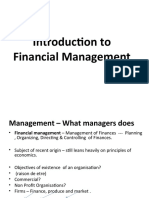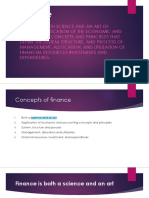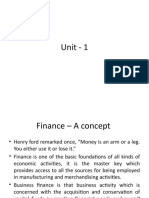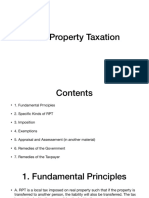Financial Management - Introduction and Financial System[1]
Uploaded by
shahsakshi010206Financial Management - Introduction and Financial System[1]
Uploaded by
shahsakshi010206FINANCIAL
MANAGEMENT
Learning outcomes
• Explain the significance of financial management to
firm performance.
• Apply time value of money related concepts in
personal finance choices.
• Apply relevant formulae to capital budgeting and
capital structure related choices.
• Explain sources of funds.
• Apply relevant formulae to working capital related
choices.
Topics covered
• Financial Management- An overview
• Sources of funds
• Time value of Money
• Capital Budgeting
• Capital Structure and cost of capital
• Working capital
• Cash Management
• Credit Management
Textbook
Chandra, P. (2023). Financial Management – Theory
and Practice, 11th edition, McGraw Hill Education
(India) Private Limited. New Delhi.
Introduction
• Financemay be defined as the art and science of
managing money.
• Finance is the life blood of Business.
• Financial Management is concerned with the duties
of the financial managers in the business firms.
Finance
• Financial Management is an operational activity, which is
accountable for the effective utilization of funds necessary for
operations.
• One of the primary objectives of financial management is to
maintain enough money to meet the necessary current and
capital expenditure, apart from maximizing profits.
• "Finance is the management of money and other valuables,
which can be easily converted into cash."
Forms of Business Organization
• Sole Proprietorship
• Partnership
• Cooperative society
• Company
• Public
• Private
Financial Decisions in a firm
• Investment Decision: Selection of
Capital appropriate investment proposals
Budgeting
• Financing Decision
Capital • Raising of funds
Structure • Capital allocation
• Dividend Decision
Capital • Allocation of Profits
Structure
Working Capital • Short-term financial management
Management
Investment Decision
• The investment decision which is known as capital budgeting
decision, is concerned with the selection of an investment
proposal and the investment of funds in the selected proposal
or proposals.
• The proposal with higher return than the require return is
selected.
• Decision of investment is need to be taken which can be long
term or short term.
Financing decision
• The financing decision is concern with the raising of funds
that finance the assets of firm.
• Funds should be adequate to procure the assets necessary
for operation, at the same time, if the funds are more than
required, the access would remain unutilized making no
contribution to output but adding to the financing cost,
thereby considerably eroding profitability.
• In other word, the financing decision should ensure optimum
capitalization.
Dividend Decision
• A part of the profit is distributed as dividend and the rest is
retained with in the firm for the purpose of investment.
• It is the dividend decision that helps to determine how much
of profit is to be distributed as dividend and how much is to
be retained with the firm.
Working Capital Decision
• The working capital decision takes into account the
management of current assets and current liabilities
• The management of current assets involves a couple of
issues.
• The first is on size of current assets, i.e. what the size of
cash holdings, short-term marketable securities, account
receivables and inventory.
• The second issue is related to the share of current liabilities
in total liabilities. Again the mix of long term and short term
capital is also important.
Goal of Financial Management
Profit Wealth
Maximisation Maximisation
Efficiency Improve the
of value of
business. shareholders.
Help to Time and risk
reduce the are two major
risk. concern.
Maximizing social values/wealth
The Fundamental Principle
Risk-Return Tradeoff
Impact of other disciplines on Financial
Management
Support Primary Disciplines:
1. Investment Analysis Accounting
2. Working capital Economics
management
3. Sources and cost of funds
4. Determination of capital
structure Support Other related Disciplines:
5. Dividend policy Production
6. Analysis of risk and return Marketing
Resulting in
Shareholder wealth maximisation
Relationship of Finance to
Economics and Accounting
• Relationship to Economics
• Relationship to Accounting
Emerging Role of Finance Manager
• Investment Planning
• Financial structure
• Mergers, acquisitions and restructuring
• Performance Management
• Risk Management
• Investors’ communication
Agency Problem
• Thereis a Principal-Agent relationship between
managers and shareholders.
• In theory, managers should act in the best interests
of shareholders.
• In practice, managers may maximize their own
wealth (in the form of high salaries and perks) at the
cost of shareholders.
• This conflict is known as Agency problem and it
results into Agency costs.
Organisation of Finance Functions
• It has to be sound and efficient.
• Under the direct control of the board of
directors.
• Why?
• For survival of firm
• Determine solvency of the firm
• Help to analyse and save additional cost
Indian financial System
Savings Investments
What is Financial System?
• The financial system deals with financial transactions
and the exchange of money between savers,
investors, lenders and borrowers.
• Subset of economic system.
• Broadly classified into the formal and informal
financial system.
• Formal financial system consist of four segments:
Financial institutions, Financial markets, Financial instruments,
and Financial services.
Functions of the Financial System
• Mobilize and allocate savings
• Pooling of Funds
• Payment system
• Risk management
• Policy implementation
• Information provider
• Liquidity
• Lower transaction costs
Financial System
Risk & Return Risk & Return
Financial
Institutions
Funds
Funds
Lenders Borrowers
Funds
Funds
Financial
Markets
Risk & Return
Risk & Return
Financial Institutions
• Mobilize savings and facilitate the allocation of funds
in an efficient manner.
• Banking Institutions
• Non-banking Institutions
• Mutual fund
• Insurance
• Housing finance companies
• Post reforms, most of financial institutions now resort
to financial markets for raising funds.
Rationale for Financial Intermediaries
• Diversification
• Lower transaction cost
• Economies of scale
• Confidentiality
• Signalling
Financial Markets
• Provide facility for demands and
requirements interact to set a price.
• Financial markets play a very pivotal role in
allocating resources in the economy by
performing three important functions as
they:
• Facilitate price discovery
• Provide liquidity
• Reduce the cost of transacting
Financial Instruments
• A financial instrument is a claim against a person or an
institution for payment, at a future data, sum of money
or periodic payment in the form of interest or dividend.
• Primary securities
• Secondary securities
Financial Services
• Help with borrowing and funding,
• lending and investing
• Buying and selling securities
• Payments and settlements
• Managing risk
Summing up
• The financial system – consisting of a variety of institutions,
markets, and instruments related in a systematic manner –
provides the principal means by which savings are
transformed into investments.
• The financial system provides a payment mechanism,
enables the pooling of funds, facilitates the management of
uncertainty, generates information for decentralized
decision making, and helps in dealing with informational
asymmetry.
Thank You!
You might also like
- Introduction-to-finanace-09122024-014803pmNo ratings yetIntroduction-to-finanace-09122024-014803pm31 pages
- Introduction To Basic Elements of Financial ManagementNo ratings yetIntroduction To Basic Elements of Financial Management27 pages
- # Chapter 1 - Introduction To Financial ManagementNo ratings yet# Chapter 1 - Introduction To Financial Management36 pages
- Introduction To Financial Management BM40002: Course Instructor Dr. Devlina ChatterjeeNo ratings yetIntroduction To Financial Management BM40002: Course Instructor Dr. Devlina Chatterjee32 pages
- Introduction To Financial Management 712014No ratings yetIntroduction To Financial Management 71201425 pages
- Corporate Finance I Module 1 5excmn8wfmNo ratings yetCorporate Finance I Module 1 5excmn8wfm23 pages
- 1618820278financial Management Consolidated 1 PDFNo ratings yet1618820278financial Management Consolidated 1 PDF85 pages
- TOPIC 1 - Objectives and Scope of Financial ManagementNo ratings yetTOPIC 1 - Objectives and Scope of Financial Management48 pages
- 4ac38600 Bcc3 4206 81d0 6d9cd5506633 Financial Management Lecture NotesNo ratings yet4ac38600 Bcc3 4206 81d0 6d9cd5506633 Financial Management Lecture Notes99 pages
- Financial Management Unit 1 DR Ashok KumarNo ratings yetFinancial Management Unit 1 DR Ashok Kumar115 pages
- Lecturr 1 - Financial Recourses ManagementNo ratings yetLecturr 1 - Financial Recourses Management33 pages
- Module 1 Intro to Financial Management-1No ratings yetModule 1 Intro to Financial Management-157 pages
- The Art of Corporate Finance: Smart Strategies for Sustainable Growth: The Leadership CodeFrom EverandThe Art of Corporate Finance: Smart Strategies for Sustainable Growth: The Leadership CodeNo ratings yet
- Corporate Finance Basics: A Beginner’s Guide to Financial Decision-MakingFrom EverandCorporate Finance Basics: A Beginner’s Guide to Financial Decision-MakingNo ratings yet
- Take Control: The No-Fail Guide to Financial FreedomFrom EverandTake Control: The No-Fail Guide to Financial FreedomNo ratings yet
- Dividend Investing: Passive Income and Growth Investing for BeginnersFrom EverandDividend Investing: Passive Income and Growth Investing for BeginnersNo ratings yet
- How Beginners Achieve Financial Success: A Guide to Understanding Risk and ReturnFrom EverandHow Beginners Achieve Financial Success: A Guide to Understanding Risk and ReturnNo ratings yet
- Dividend Investing: A Comprehensive Guide to Building Wealth Through Passive Income for Achieving Financial Freedom and Long-Term SuccessFrom EverandDividend Investing: A Comprehensive Guide to Building Wealth Through Passive Income for Achieving Financial Freedom and Long-Term SuccessNo ratings yet
- Conflict of Interest COI Quick Guide and Case StudiesNo ratings yetConflict of Interest COI Quick Guide and Case Studies16 pages
- Ayda Khadiva - 29120578 - BATNA WorksheetNo ratings yetAyda Khadiva - 29120578 - BATNA Worksheet1 page
- Reading 15 Analysis of Dividends and Share Repurchases - AnswersNo ratings yetReading 15 Analysis of Dividends and Share Repurchases - Answers31 pages
- Download Understanding Housing Defects 2nd Edition Duncan Marshall Bsc Mciob Mbeng ebook All Chapters PDF100% (10)Download Understanding Housing Defects 2nd Edition Duncan Marshall Bsc Mciob Mbeng ebook All Chapters PDF81 pages
- Structure and jursdiction of courts in Kenya- notesNo ratings yetStructure and jursdiction of courts in Kenya- notes11 pages
- User Guide: Ibm Qradar User Behavior Analytics (Uba) AppNo ratings yetUser Guide: Ibm Qradar User Behavior Analytics (Uba) App294 pages
- Axis T91a Mounting Accessories Installation Guide en US 37754No ratings yetAxis T91a Mounting Accessories Installation Guide en US 3775466 pages
- RISK MANAGEMENT AND OTHER FACTORS PREVENTING FRAUDULENT FINANCIAL REPORTING BY STATEOWNED ENTERPRISES IN INDONESIAAsian Economic and Financial ReviewNo ratings yetRISK MANAGEMENT AND OTHER FACTORS PREVENTING FRAUDULENT FINANCIAL REPORTING BY STATEOWNED ENTERPRISES IN INDONESIAAsian Economic and Financial Review25 pages

























































































